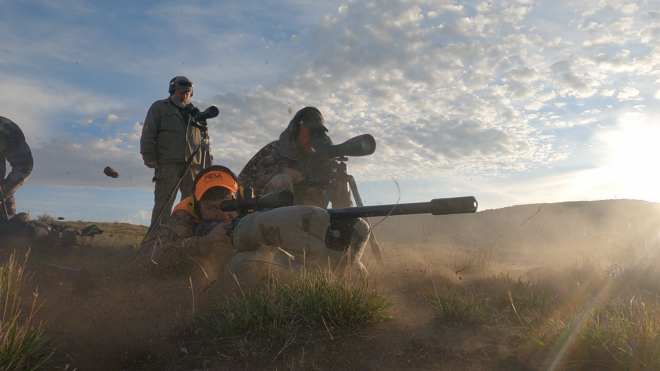I was recently invited to a private event to observe a side of firearms in which I am astoundingly ignorant. My knowledge of muzzleloader shooting (and the voodoo art/science of muzzleloading) could have fit into a spent 22LR casing with room to spare. After this event, though I am most definitely intrigued and wondering if I can afford to pick up a new facet of shooting.
I packed up the truck and headed north to a private ranch outside of Craig, Colorado.
I did do a little bit of familiarization prior to coming out to this event–but it was mainly to confirm my preconceived notions–that muzzleloading was a short-range game.
Mesa Precision Arms (https://mesaprecisionarms.com/) teamed up with Kyle Pittman (of Pittman Bullets; https://www.pittmanbullets.com/) and Bill Travis (“Hillbill”) to push the bounds of what a muzzleloader can do. Now before some of you become apoplectic over the use of smokeless powder and start rage posting photos of blown-up guns in the comments, understand that these individuals are at the top of their game. It is risky? Yes. But apparently so is walking to the restroom in a restaurant without a mask.
Muzzleloading with smokeless powder is not for everyone, and it is most certainly not for beginners. In essence, you are “reloading” a cartridge directly down the barrel of a long gun, assembling the components “blindly”. You need to have the right tools, training, and experience to do this safely. Which means an investment in time and equipment that a lot of people are not willing to do. For those that are, a new aspect of shooting is revealed to you. If you are a precision shooter, this adds in a whole ton of new variables, internal to the gun, which you must account for.
The attempt
I met with the group in the morning at the hotel breakfast area (for the record it was a bait and switch–the hotel was supposed to have waffles and other breakfast stuff, but instead had weak “to go” bags). I scarfed down my muffin and orange, and we headed out to the range–a ranch about 15 minutes away.
I had been shanghaied into coming for the promise of seeing a muzzleloader shoot sub-MOA at 1,000 yards. Which of course is ridiculous, or so I thought. Shooting that tight with centerfire is a challenge. A muzzleloader? No way. But I trusted my contact that set this up.
When we got out to the range everyone was being a little cagey and it seemed like something else was going to be demonstrated. At that point, Bill and Kyle informed me that they would be attempting a mile shot. I shook my head because I clearly had not heard correctly. They repeated.
I asked what the course of fire would be and was told they’d probably warm up by shooting at the 1500 yard target.
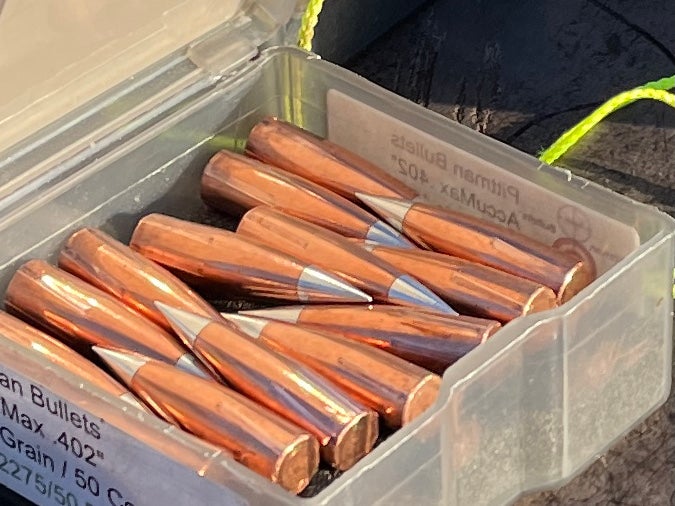
The projectiles are Pittman Bullets, .402″, 350-grain Aeromax. Were you expecting Minie balls?
This was not, by definition a “cold bore” attempt at a mile. The previous evening the entire gun had been cleaned and inspected, everything tightened and secured.
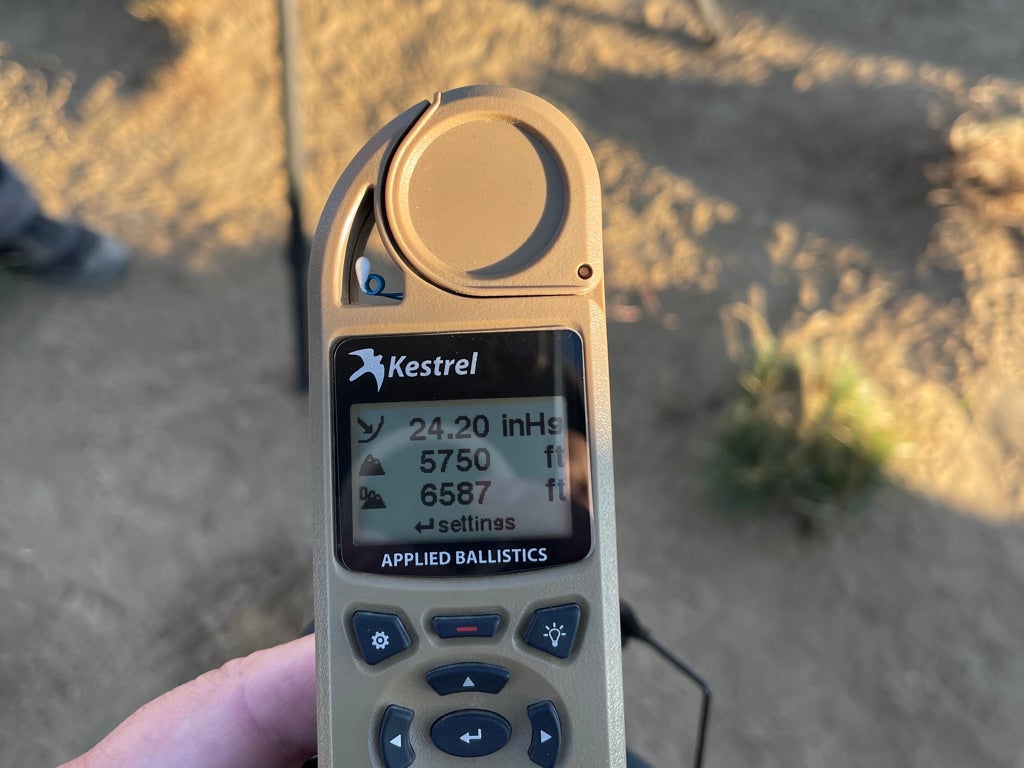
While the team was setting up the plethora of recording devices, I went ahead and grabbed some environmental. Density altitude was at a mere 6,587 feet. The few times I have shot to a mile, I’ve had the fortune to be in the highlands of New Mexico and shooting at an effective 10,000+ feet.
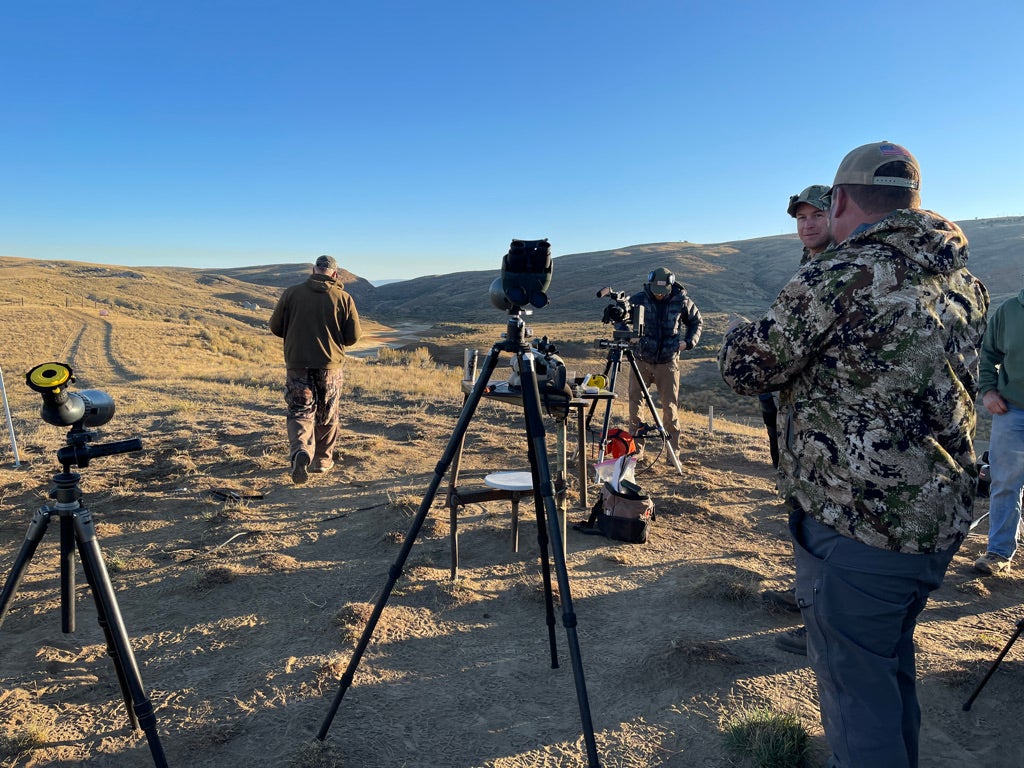
Some of the recording devices to verify and confirm the attempts: spotting scope with PhoneSkope mount for a GoPro, Swarovski spotting scope for human eyes, shooter facing camera (yes the photographer moved behind the shooter during the attempt).
The first shot taken was just to foul the barrel. The second shot was to be at 1500 yards. It was an impact.
Since 1500 was easy-peasy, Bill decided to just go for it. The rest of the shots were taken at the plate at 1780 yards.
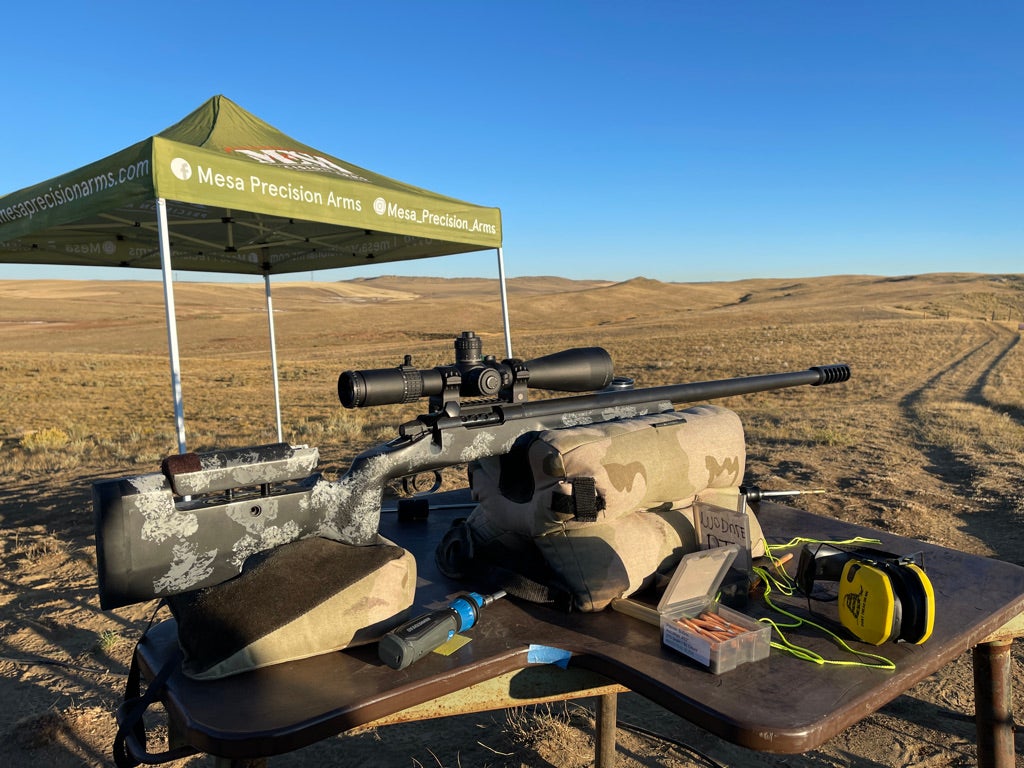
Did I mention Bill shot from a bag rest (and not a sled or bench)? No? I must have forgotten to mention that…
The plate was a 31.5-inch square and had a Magnetospeed target hit indicator.
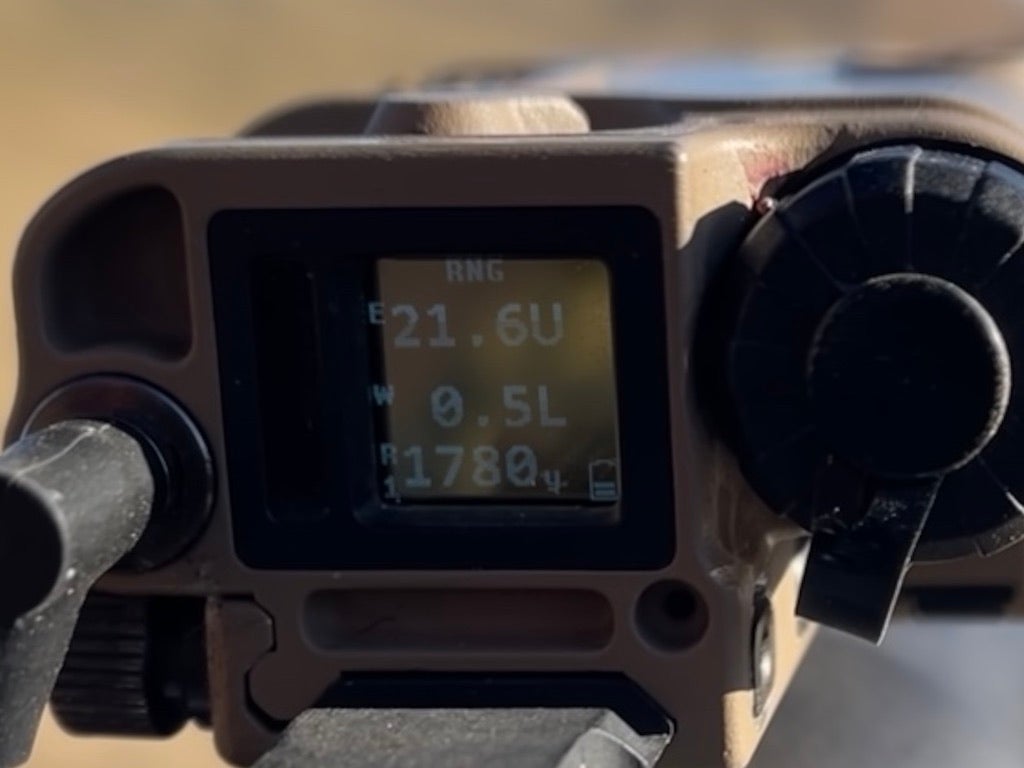
The distance was confirmed with a Wilcox Fire Control System.
Eight shots were fired at the target with a mean time between shots of around 102 seconds. The first shot was a smidge high (and I think hit the hanger strap). The second shot was a bit low and impacted the dirt just below the target. The third round hit (which was technically only the fifth round of the day). The next four shots also rang steel. The eighth shot finally missed. Bill had declared he was going to send rounds until he missed and he followed through with that.
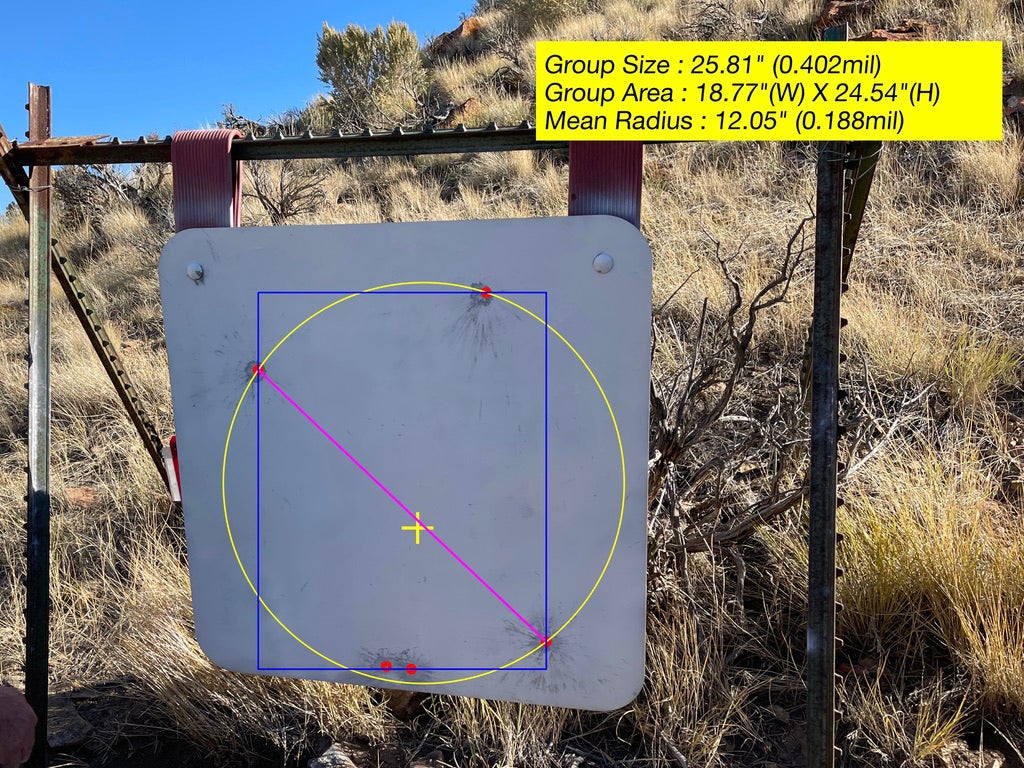
Okay, so it wasn’t sub-MOA. I think I’ll let that claim slide…
Five shots (rounds three through seven) all impacted the target directly. The eighth was still really damn close. Amazing shooting. That kind of shooting is challenging enough with a centerfire, where you have the ability to rapidly follow on with multiple shots once you have a good firing solution. I recall a time up at Whittington Center, sending a second and third shot before the first hit the target. With a muzzleloader, you do not have that luxury:
- The gun comes up and off of the firing position.
- The powder is poured into the barrel.
- A projectile is pushed down with a long rod and confirmed via witness marks on the rod.
- The weapon is put back in the firing position.
- A new module is inserted (basically the reusable primer).
- Shooter gets back into position and reacquires the target.
- Wash. Rinse. Repeat.
Here is the video of the shots:
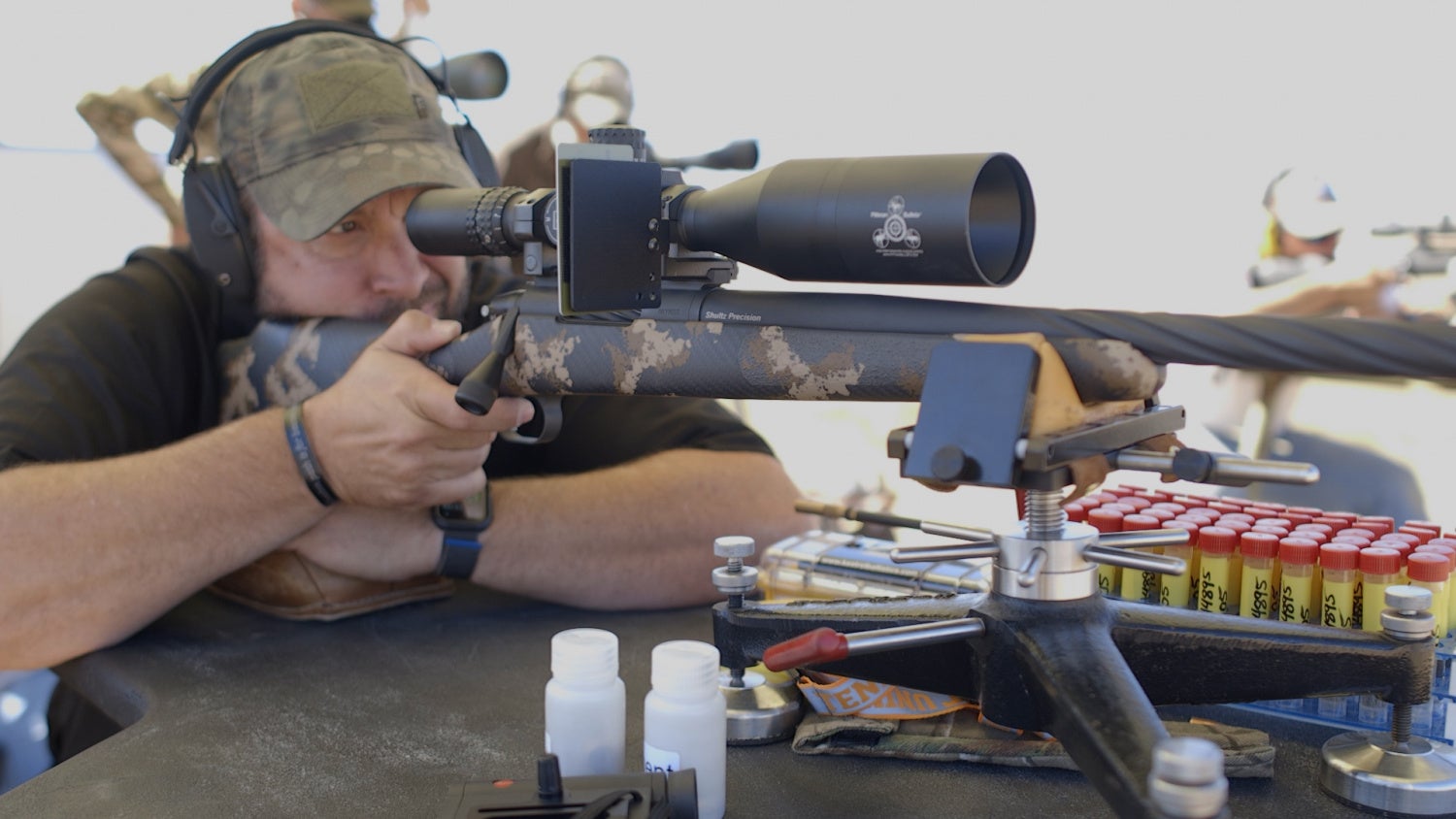
The author taking his first-ever shot from a muzzleloader.
Kyle gave me the opportunity to shoot his muzzleloader at the 1000 yard target. By that point it was starting to get warm, that target area had heated up, and we had some shifting winds (full value to third value). I only took a few shots, came close, but ultimately missed. This is not a ding on the rifle–just me the shooter. The muzzleloader definitely had some kick to it–maybe a little less than a 12-gauge.
Rifle Specifications
The rifle used for the 1,780-yard shot was a highly customized build. As of right now, there is no off-the-shelf muzzleloader that you can buy at Dicks Sporting Goods and plink steel at a mile.
Bill’s custom rifle featured the following components:
- Mesa Precision Stock and Action
- Brux Barrel (1:14 twist, 30-inch)
- Terminator Muzzle Brake
- Hankins Direct Ignition system
- And, of course, Pittman Bullets Aeromax 350 grain, 0.402″ projectiles
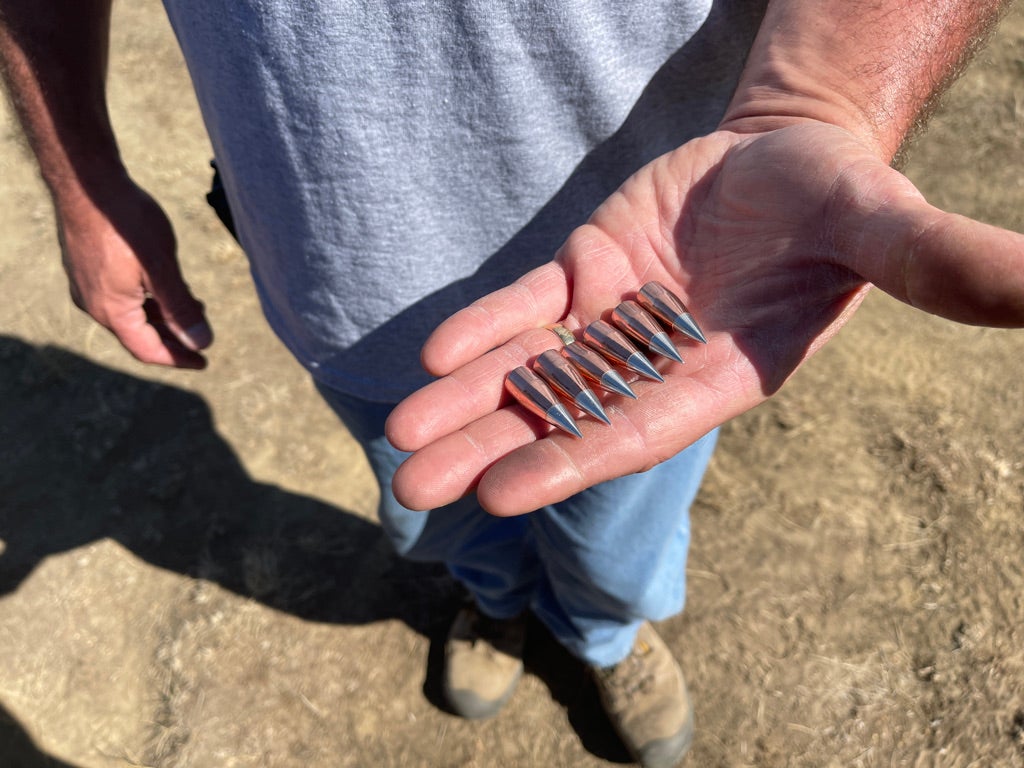
While all of the components of the rifle contributed to the success of the shots, the action, and the projectiles had a lot to do with it.
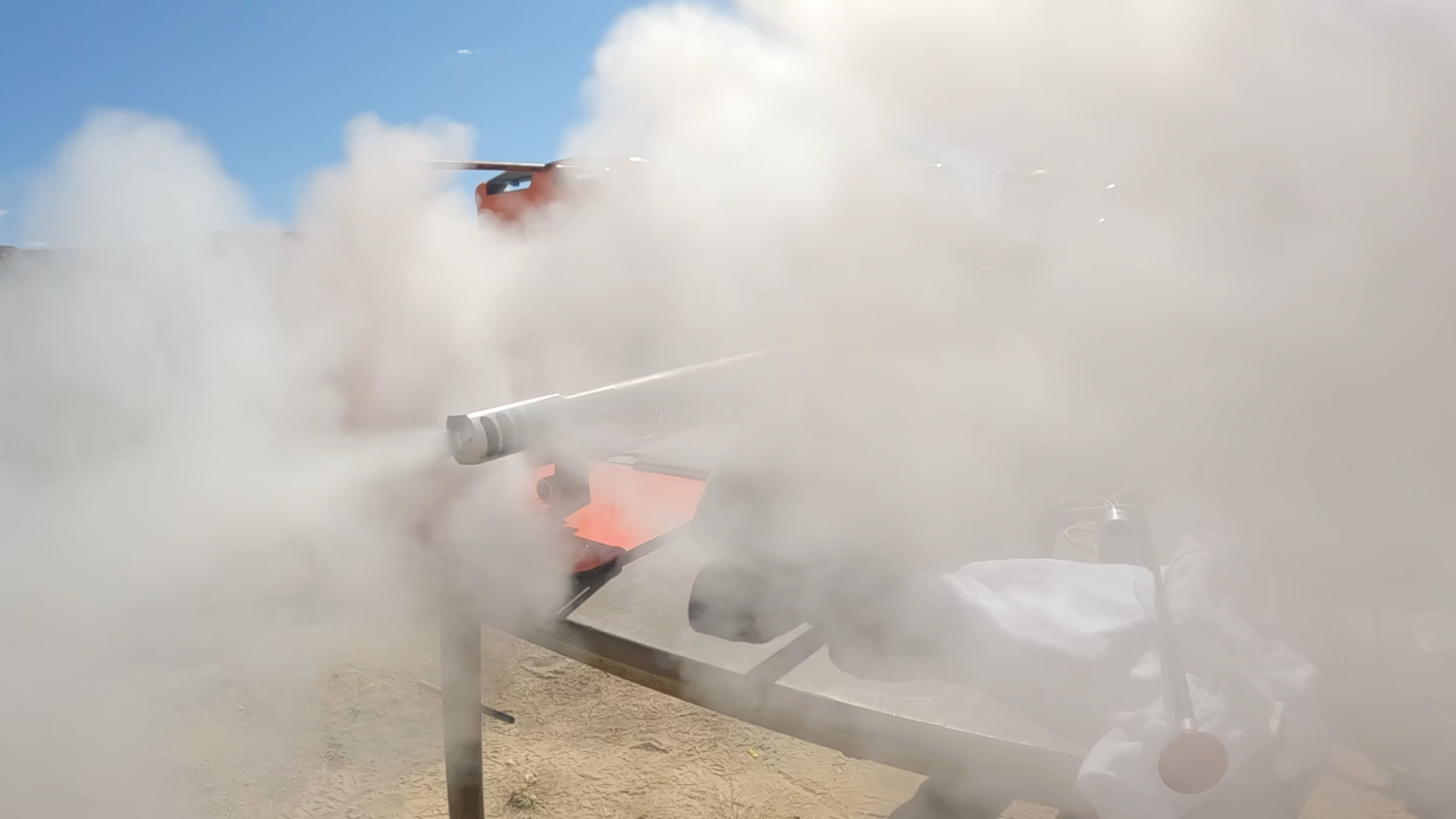
Yes, it was smokeless powder… 🙂
Obviously, the design of the projectile is critical. The weight and balance, along with the material composition and shape, contribute to determining how that chunk of metal flies through the air and maintain stability. Kyle Pittman got into muzzleloading and found what he determined to be a gap in design. There just wasn’t a projectile available that had the performance he thought there should be. So he set out to create one. And create one he did. He holds the utility patent (#10,921,104) on the design of the tip need to make the AccuMax and trademarked Aeromax projectiles. The proof is in the pudding as they say (or maybe it is in the strike marks on that steel plate).
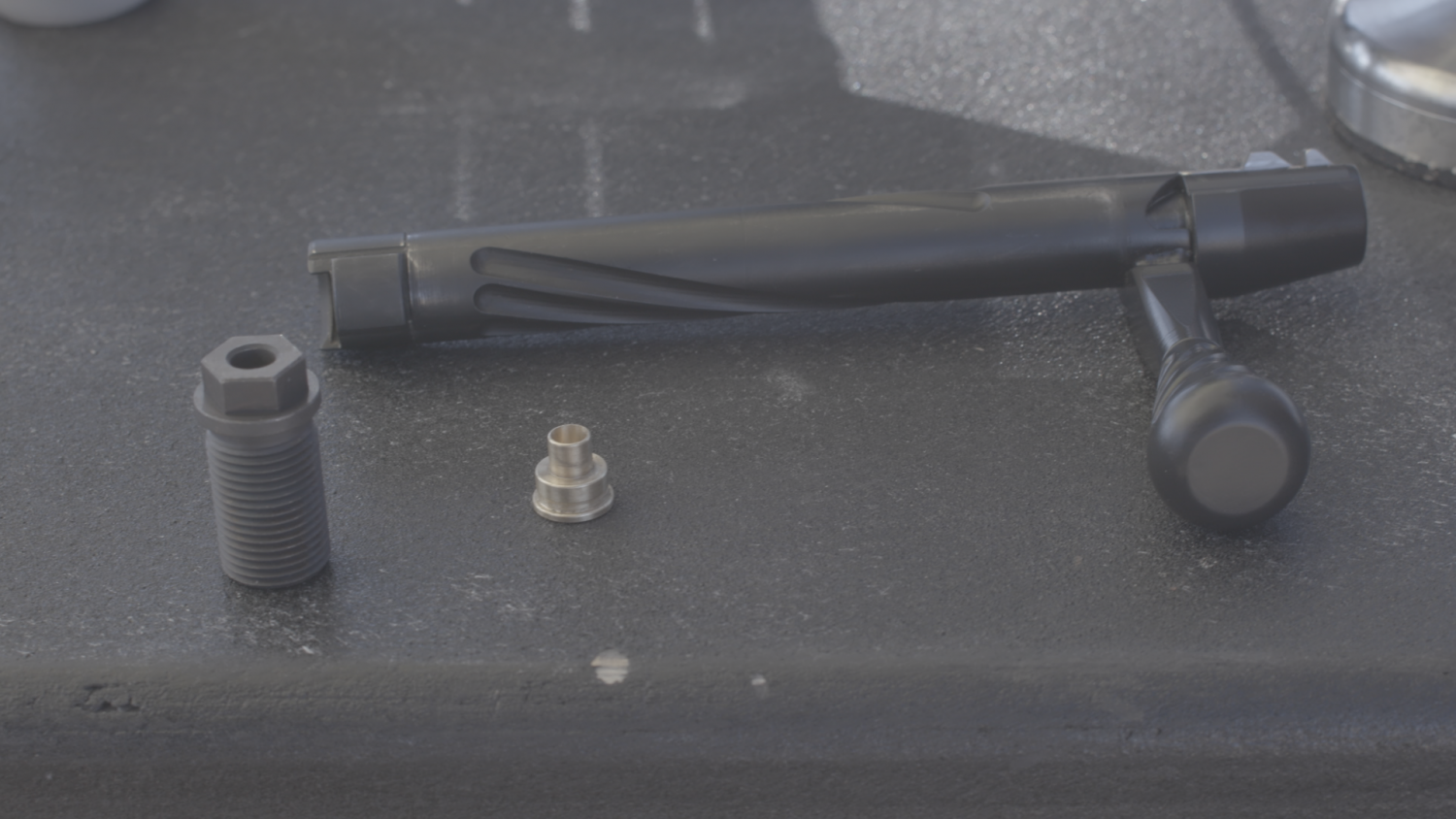
John and Chad of Mesa Precision also had a part to play. Their action and stock made up parts of the build. Chad spent some time “tinkering” with precision shooting in the Marines as an 8541. While John spent his time shooting a slightly larger bore in the Marines (with 1st Tank Battalion), he’s followed a lifelong passion as a hunter, pretty much all over North America, and has more recently progressed into long-range hunting. Mesa Precision was formed to make components for precision shooting–hunting through competition.
Together they worked with Bill Travis and Kyle Pittman to assemble and craft a muzzleloader capable of these feats.
Theory made practical
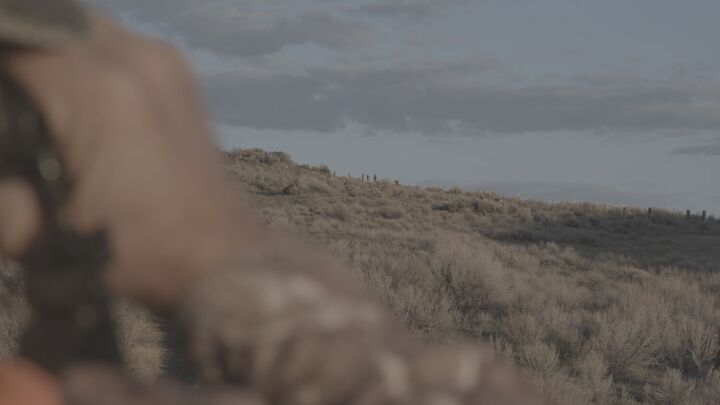
Speed goats in the distance.
One of the impressive things was to see applied theory translate to practical application within a few hours. The precision range on the Ellgen Ranch property has targets out well past a mile. It also has impressive herds of both farm and game animals.
Kyle harvested an antelope just shy of 300 yards with his muzzleloader. Pronghorn antelope are known as “speed goats” and are the fastest land mammal in North America (technically they are the second fastest on Earth, behind the cheetah, if you want to get technical).
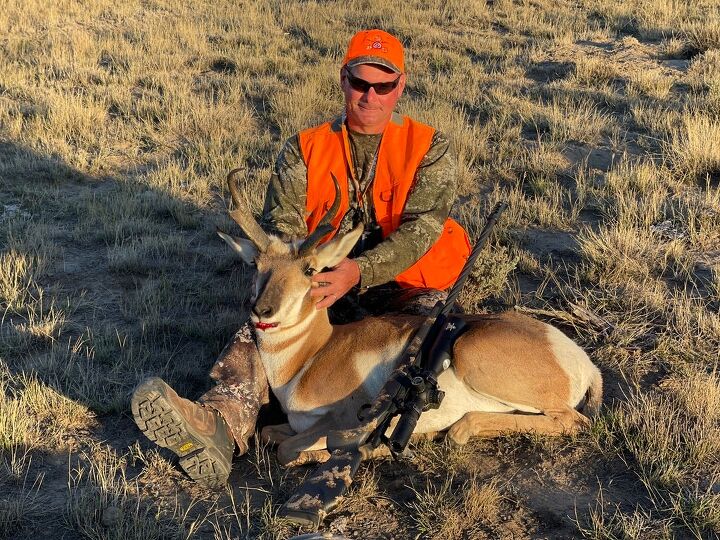
It was a great shot from any platform. Even more impressive with a muzzleloader. You need to be supremely confident in your skills and have impeccable DOPE on your gun to hunt long distances with a muzzleloader. With only one shot, you run the risk of just injuring the animal–which no one wants. Kyle and Bill are both top-tier marksmen with their platform.
With a centerfire rifle (or even archery hunt), even as fast as antelope are, you likely have the ability to make a follow-on shot, especially if your first shot didn’t immediately drop the animal. With a muzzleloader, your follow-up shot won’t be for a few minutes, all the while your focus is entirely upon reloading your gun–meaning you are not tracking the animal. You need to make the shot count and deliver enough energy to the target to stop it “right there”. Kyle’s shot, a 303-grain Aeromax HardCore projectile leaving the muzzle at 3060 ft/sec, conservatively imparted upwards of 3500 ft/lbs of energy. The antelope dropped like a rock–instant “lights out”. It was about as quick and ethical a kill as I have seen.
The following day Bill decided to make his harvests. A buck at 733 yards and a doe at a mere 896 yards. Both were single shots that dropped the animals in place.
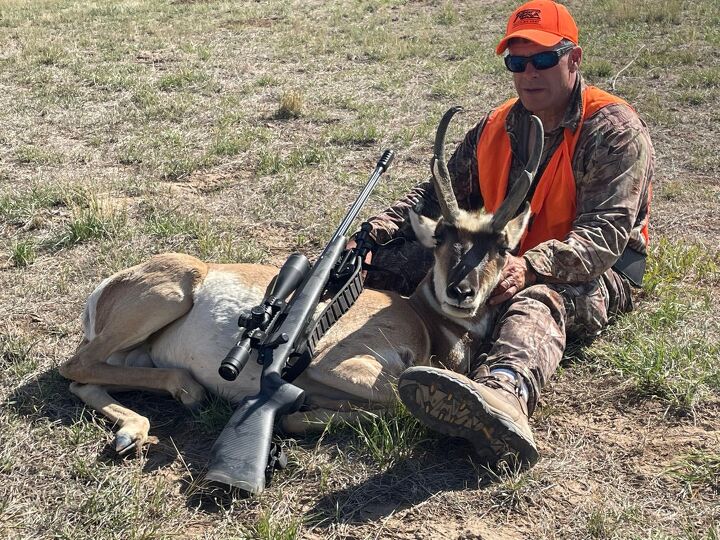
Bill’s buck antelope, taken at 733 yards.
Not really much more to say there. Both of these gentlemen proved that muzzleloaders are far more capable than most people know, lobbing massive projectiles out to extreme distances with enough energy to rapidly and ethically bring down game.
Conclusion
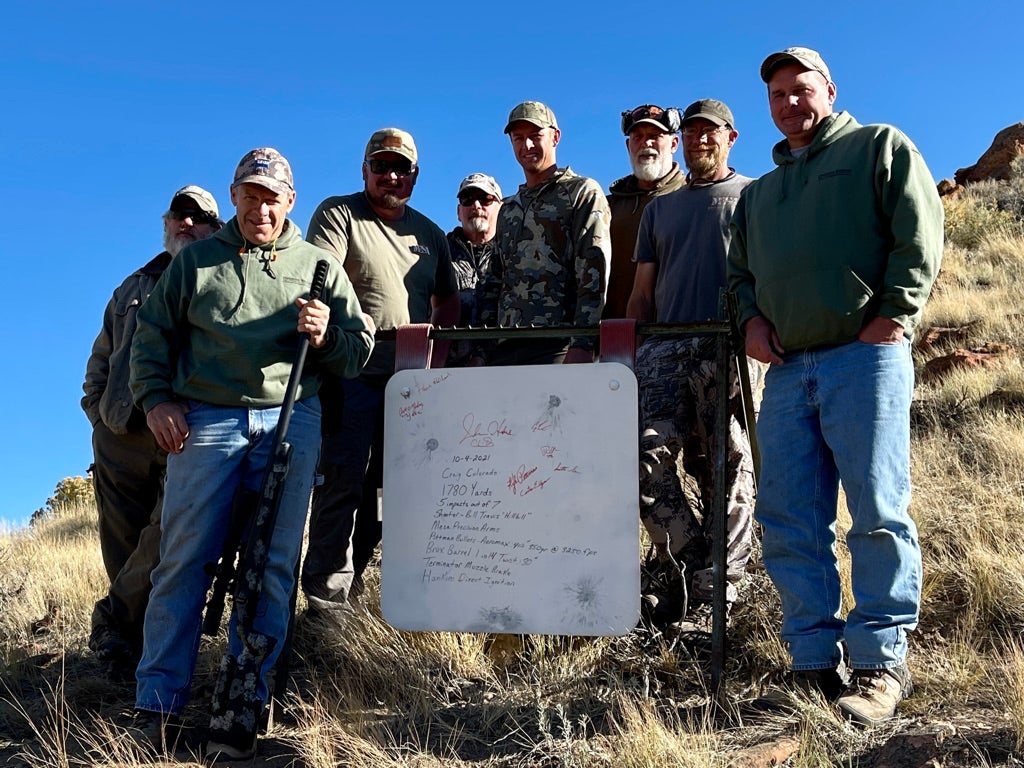
The team responsible for the shoot. From left to right: Chad Drayer (Mesa Precision Arms), Bill Travis (shooter), John Hakes (Mesa Precision Arms), tall guy in the center was Curtis Ellgen (Ellgen Ranch Outfitters; it was on his ranch), and on the right Kyle Pittman (Pittman Bullets). The others of us were supporting staff and witnesses.
My preconceived notions of the capabilities of muzzleloaders being a short-range, semi-accurate weapon were reset during this event (and I realize that may have been a total mischaracterization but it is what I assumed). I witnessed a level of precision, accuracy, and practical application that shooters with custom centerfires are challenged to make.
It feels like this facet of shooting sports and hunting has some innovation and growth ahead of it that is ripe for expansion. Those individuals that are willing to invest the time and training in understanding the safety and technical aspects of running a muzzleloader have both a fun and practical future awaiting.
To learn more about muzzleloading, Bill Travis said that “Hank’s Message Board” is the “go-to” forum (he is a moderator there as well) https://hanksmessageboard.freeforums.net/. You can learn more about Pittman Bullets at his website: https://www.pittmanbullets.com/. And last, but certainly not least, check out Mesa Precision Arms at: https://mesaprecisionarms.com/. Big thanks to all of these contributors for pulling together this event and inviting TFB out to witness this shoot.
Photos credits to Mesa Precision Arms (taken by Evan Kruse).
 Your Privacy Choices
Your Privacy Choices
